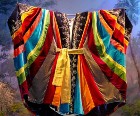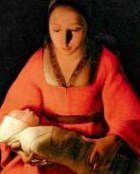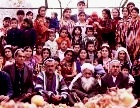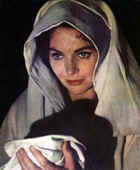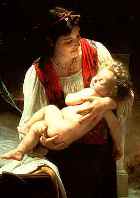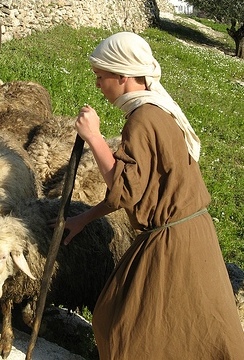
A shepherd’s clothing
Clothing for children & babies
In Bible times, all clothes were made by hand by the women of the family. There were of course no store-bought clothes.
Then, as now, mothers were proud of their babies and children, and did their best to make clothes that expressed their love and pride, and reflected well on the family.
Baby’s clothes
Children’s clothing is usually handed down from one child to the next, and this was certainly so in Bible times, where the families were large. These clothes were made of fabric which was discarded when it became worn. So there is very little archaeological evidence to go by.
However, we know that common items of baby clothing were
-
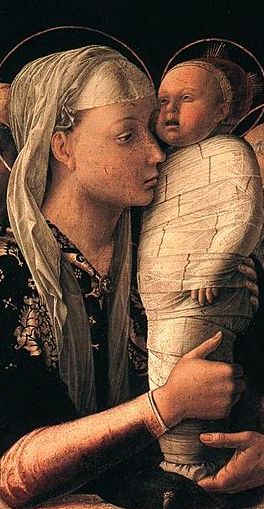
Swaddling bands in a medieval painting of the Infant Jesus
Swaddling clothes, made of long strips of linen which were wrapped around the baby’s body so that the arms and legs were held fairly firmly. This simulated the security of the womb, and calmed the baby. Modern women use a cotton shawl wrapped firmly around their baby’s body to achieve the same result.
- The swaddling clothes were used until the baby began to get some strength in its arms and legs. In the image at right, the bottom of the Christ Child is discreetly covered by the medieval artist Mantegna, though in reality Jesus’ little bottom would have been bare.
- As far as we know, there were no nappies. The baby’s bottom was left bare. Most women carried their babies with them all the time and were able to tell when their baby was about to ‘do a poo’ (I can’t think of a polite way to say this!) and would quickly hold the baby out over a pot, then wipe its bottom clean. The linen strips could be easily washed and dried, and changed as often as needed.
- Luke’s gospel (2:7) mentions that the baby Jesus was wrapped in swaddling clothes, and you would wonder why this would need to be mentioned. Luke probably said it for two reasons, (1) to emphasise that Jesus was a real human baby, not a little pagan god who did not have a normal human body, and (2) to show that Mary was a respectable young woman who had prepared suitable clothing for the baby she expected to bear.
- A baby in Bible times was also wrapped firmly in a woolen shawl, perhaps several of them, and then in a sort of carry-bag on the mother’s back. This was because the mother had to have both arms free for work. The bag would have been soft leather or thick woven wool.
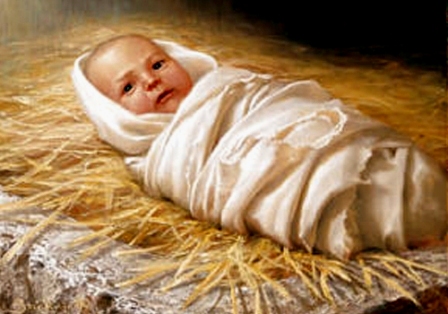
Children’s clothes
- As the child grew, it was dressed in a sort of shapeless tunic (see below), also woven from wool, and sandals or little boots as well. Below is a child’s garment found by archaeologists south of Cairo. It was woven from coloured wools as a single piece of cloth folded over at the shoulders. It appears to have been darned or
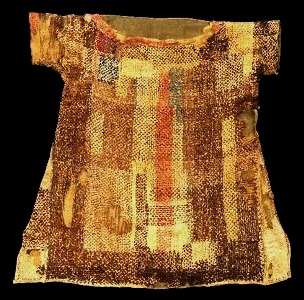
A child’s garment found by archaeologists south of Cairo. It was woven from coloured wools as a single piece of cloth folded over at the shoulders. It appears to have been darned for recycling.
mended in several places, which suggests it was handed down from one child to the next. The fabric was evidently woven from several different coloured threads.
- As for the design, children probably wore a small version of the first four of the following garments worn by adults:
- a linen or woolen shirt, the haluk, worn underneath the tunic
- the tunic itself ‘woven without seam'(John 19:23)
- a linen or woolen girdle wrapped around the waist (Matthew 3:4)
- leather sandals for the feet
- an upper garment (Mark 9:3) probably made of white wool, with tassels at the corners.
- Goat’s or sheep’s wool was the most popular fibre for clothing for ordinary people. Linen was more difficult to produce, and poorer people often gained additional income by making and selling it.
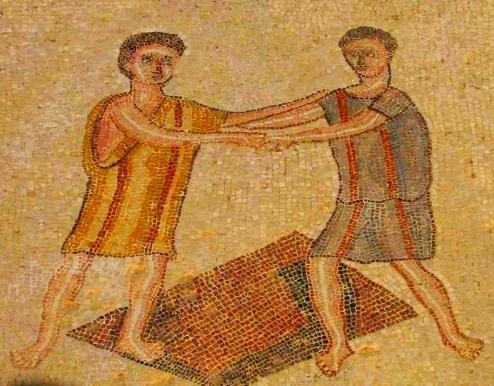
Mosaic floor showing two boys wrestling; their clothing is striped-weave and probably homespun
Remnants from the Bar-Kochba War
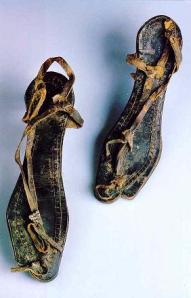
Ancient leather sandals found at Bar Kochba
During the Bar-Kochba War in 132–135 AD some fleeing Jews took shelter in a cave and died there. Because of the dry desert air some personal possessions were still intact when they were discovered in nearby caves last century.
Among the items discovered were some remnants of clothing. There were
- different pieces of linen and dyed wool, some of them very finely woven,
- as well as a spool of fine thread wound around a stone. The fineness of a thread depended on the skill of the woman and the quality of the wool.
- There were also a pair of sandals, almost intact.
Samuel’s linen garment
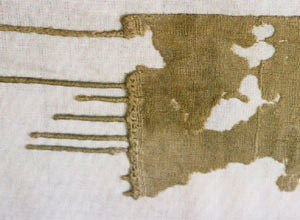
A sample of finely woven linen discovered in Egypt, circa 1,350BC
You can read the story of Hannah. It describes a special linen garment she wove for her little son Samuel as a parting gift, when he left her care to live with the priests in the Temple. (
At right is a sample of finely woven linen discovered in Egypt, circa 1,350BC.)
Hannah wove the same garment every year, each time in a bigger size, to give him each time she visited.
- From this we gather that a woman, or female relatives, made all the children’s clothes herself.
- We can also assume that there were set designs that children wore, with their mothers weaving special emblems or patterns into the fabric if they wished.
Each tribal or family group had its own special patterns, to make the clothing they wore distinctive.
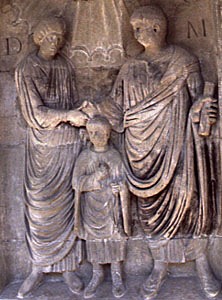
Read about more fascinating women of the Old and New Testaments
Search Box
![]()
Bible Study Resource for Women in the Bible: Clothes for babies and children in Bible times
© Copyright 2006
Elizabeth Fletcher


